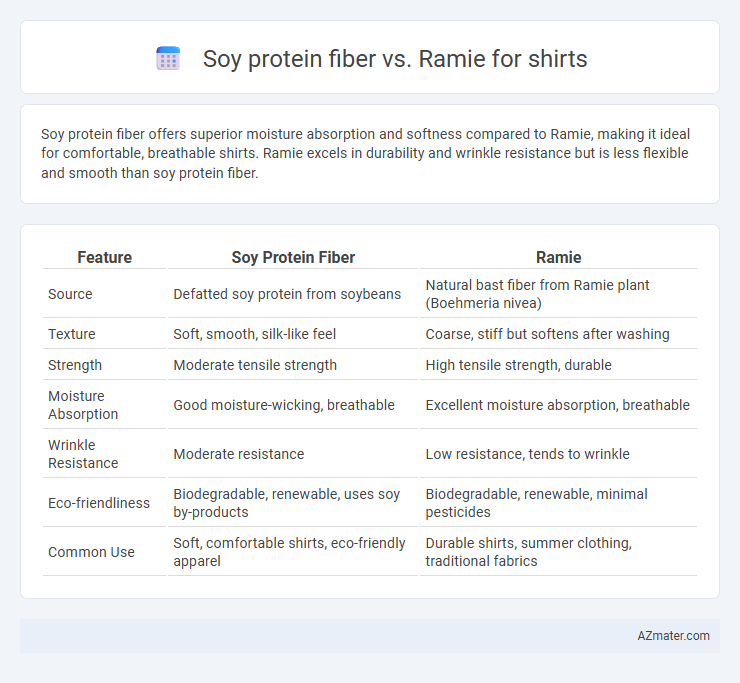Soy protein fiber offers superior moisture absorption and softness compared to Ramie, making it ideal for comfortable, breathable shirts. Ramie excels in durability and wrinkle resistance but is less flexible and smooth than soy protein fiber.
Table of Comparison
| Feature | Soy Protein Fiber | Ramie |
|---|---|---|
| Source | Defatted soy protein from soybeans | Natural bast fiber from Ramie plant (Boehmeria nivea) |
| Texture | Soft, smooth, silk-like feel | Coarse, stiff but softens after washing |
| Strength | Moderate tensile strength | High tensile strength, durable |
| Moisture Absorption | Good moisture-wicking, breathable | Excellent moisture absorption, breathable |
| Wrinkle Resistance | Moderate resistance | Low resistance, tends to wrinkle |
| Eco-friendliness | Biodegradable, renewable, uses soy by-products | Biodegradable, renewable, minimal pesticides |
| Common Use | Soft, comfortable shirts, eco-friendly apparel | Durable shirts, summer clothing, traditional fabrics |
Introduction to Soy Protein Fiber and Ramie
Soy protein fiber, derived from natural soybean protein, offers a biodegradable, soft, and moisture-absorbing alternative ideal for shirt fabrics. Ramie, a bast fiber obtained from the stalks of the Ramie plant, is known for its durability, luster, and strong wrinkle resistance, making it suitable for long-lasting shirts. Comparing these fibers reveals soy protein's comfort and eco-friendly nature versus Ramie's strength and resilience in textile applications.
Origin and Production Processes
Soy protein fiber originates from defatted soybean flakes through a process that involves extraction, fiber formation by spinning, and subsequent drying and cutting, emphasizing sustainable use of agricultural by-products. Ramie, derived from the stalks of the Boehmeria nivea plant native to East Asia, undergoes a labor-intensive process including harvesting, decortication to remove bark, degumming to eliminate gums and pectins, and fiber refining to produce a lustrous, durable textile input. The soybean-based fiber production is more industrialized and scalable, while ramie cultivation and processing remain largely traditional and manual, reflecting their distinct botanical origins and manufacturing methods.
Sustainability and Environmental Impact
Soy protein fiber is biodegradable and derived from renewable soybeans, offering a lower carbon footprint compared to petroleumbased fibers, making it a sustainable choice for shirts. Ramie, a natural cellulose fiber extracted from the stalks of the Chinese nettle plant, requires fewer pesticides and water than cotton, significantly reducing environmental impact while maintaining durability and breathability. Both fibers contribute to eco-friendly apparel, but soy protein fiber's renewable origin and ramie's minimal resource consumption highlight their roles in sustainable shirt production.
Physical Properties and Comfort
Soy protein fiber offers exceptional softness and moisture absorption, providing a smooth, breathable texture ideal for shirt comfort. Ramie fiber boasts superior strength and durability, along with high wrinkle resistance, making it suitable for long-lasting, structured shirts. Both fibers enhance breathability, but soy protein fiber excels in softness while ramie is favored for firmness and resilience.
Moisture-Wicking and Breathability
Soy protein fiber offers excellent moisture-wicking properties by efficiently drawing sweat away from the skin, making it ideal for active wear shirts. Ramie fabric excels in breathability due to its natural porous structure, allowing air to circulate freely and keep the wearer cool. Combining soy protein fiber's moisture management with ramie's superior ventilation results in shirts that maintain comfort during prolonged wear in warm conditions.
Durability and Longevity
Soy protein fiber offers excellent durability with natural elasticity that resists wear and tear, making shirts long-lasting and comfortable. Ramie fabric is highly durable and stronger than cotton, featuring resistance to abrasion and bacterial growth, which enhances the shirt's longevity. Both fibers contribute to sustainable clothing, but soy protein fiber provides superior softness while ramie excels in maintaining structural integrity over time.
Dyeing and Color Retention
Soy protein fiber exhibits excellent dye affinity due to its protein-based structure, allowing vibrant and rich color absorption during the dyeing process. Ramie, a cellulose fiber, also dyes well but typically requires mordants for improved color fastness and may fade faster under UV exposure. In terms of color retention, soy protein fiber maintains hues longer with less fading, making it ideal for shirts requiring durable, vivid coloration.
Hypoallergenic and Skin-Friendliness
Soy protein fiber offers excellent hypoallergenic properties due to its natural protein composition, reducing the risk of skin irritation and allergic reactions in sensitive individuals. Ramie fabric is also skin-friendly, known for its smooth texture and breathability, but may cause discomfort for those with extremely sensitive skin because of its stiffness. For hypoallergenic shirts, soy protein fiber is generally preferable, providing gentle, moisture-absorbing comfort ideal for dry or allergy-prone skin.
Cost Comparison and Market Availability
Soy protein fiber offers a cost-effective alternative to ramie in shirt production, typically priced lower due to its bio-based manufacturing process and widespread availability of raw materials. Ramie fiber, while valued for its strength and luster, commands higher market prices and has limited production regions, impacting its overall accessibility. The cost comparison favors soy protein fiber for budget-conscious manufacturers, while ramie remains a premium option with niche market availability.
Best Choice for Shirts: Soy Protein Fiber vs Ramie
Soy protein fiber offers superior softness, moisture-wicking properties, and biodegradability, making it an excellent choice for comfortable and eco-friendly shirts. Ramie is known for its strength, durability, and resistance to wrinkles, providing long-lasting shape retention but may lack the softness of soy protein fiber. For shirt manufacturing, soy protein fiber is optimal for comfort and sustainability, while ramie is preferred when durability and wrinkle resistance are prioritized.

Infographic: Soy protein fiber vs Ramie for Shirt
 azmater.com
azmater.com